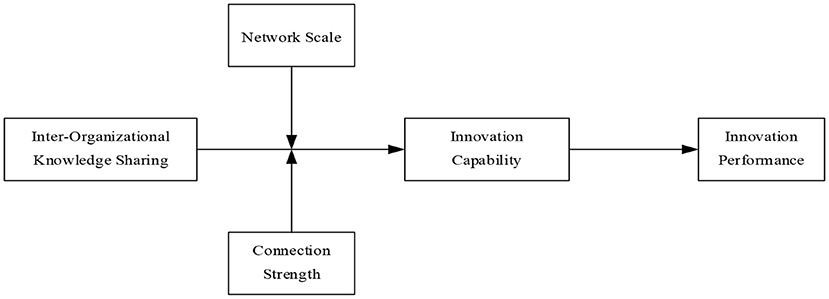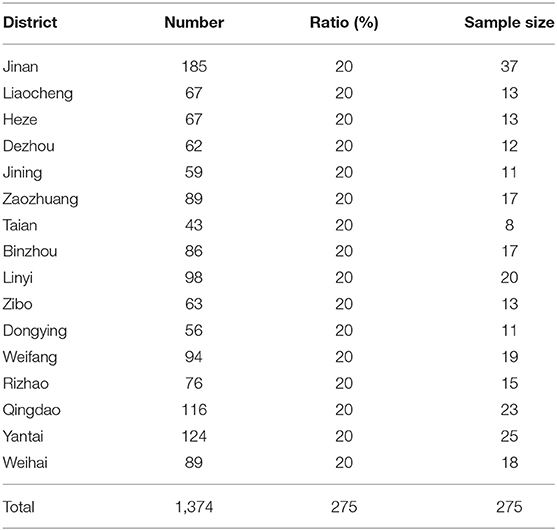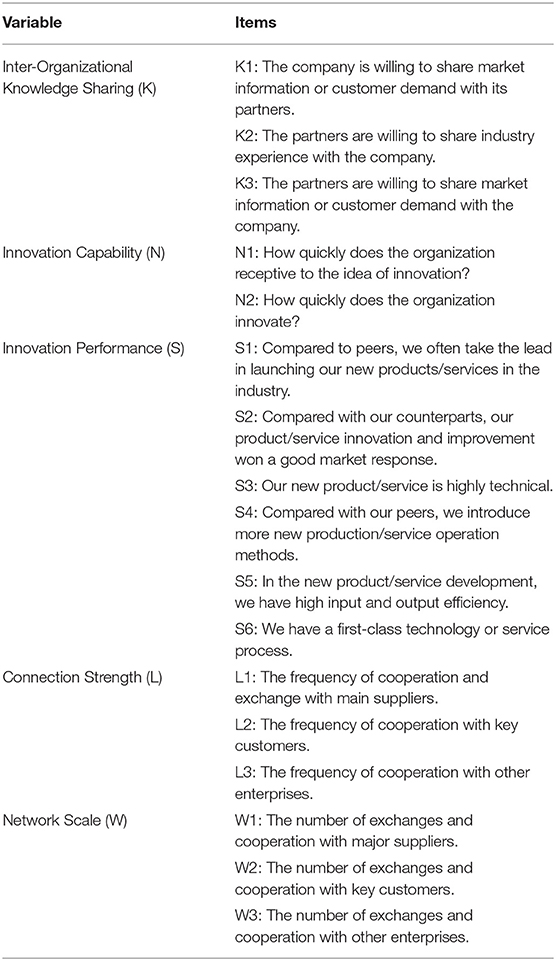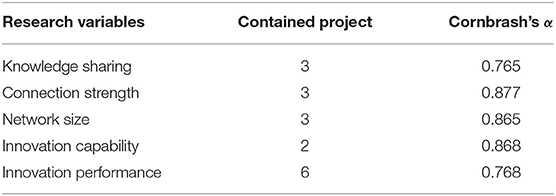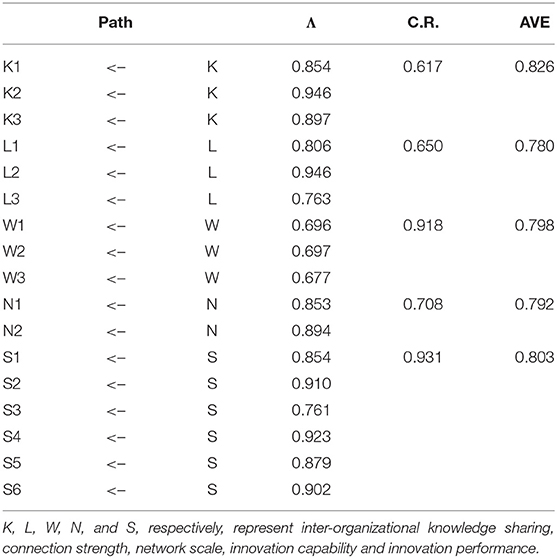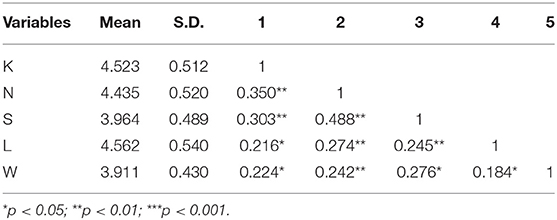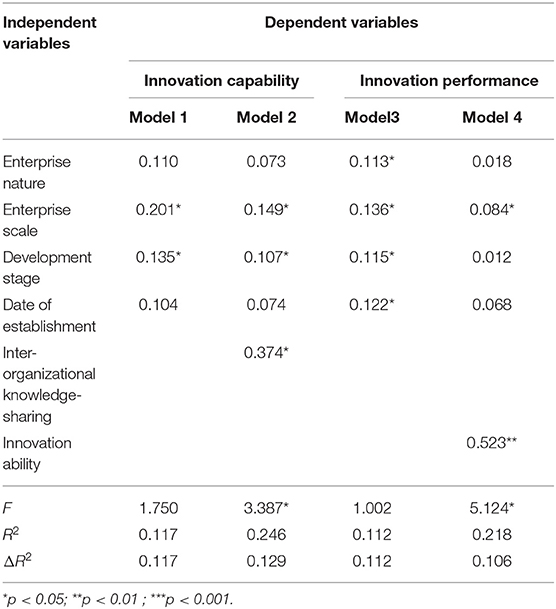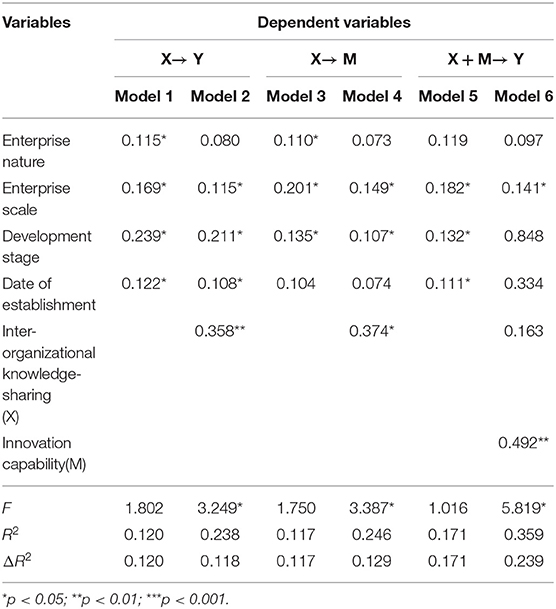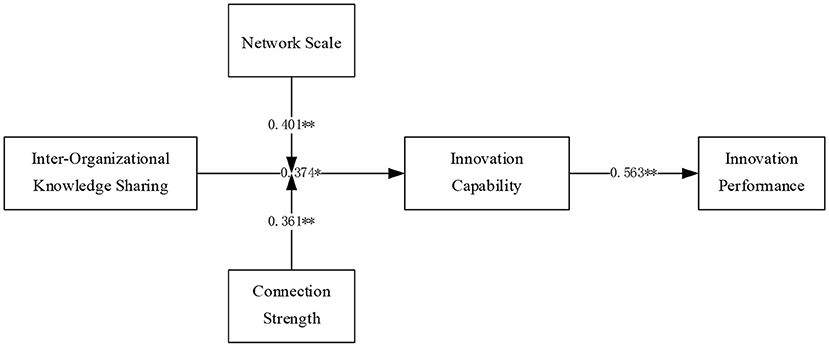- 1School of Management, Shandong University, Jinan, China
- 2School of Business, Shandong Jianzhu University, Jinan, China
- 3School of Economics and Management (Cooperative College), Qingdao Agricultural University, Qingdao, China
- 4School of Management, Qilu University of Technology (Shandong Academy of Sciences), Jinan, China
- 5School of Finance and Taxation, Shandong University of Finance and Economics, Jinan, China
This study investigates the relationship between inter-organizational knowledge-sharing and innovation performance based on the resource-based theory and network embedded theory. It aims to examine the mediating effect of network characteristics in the relationship between inter-organizational knowledge-sharing and innovation performance. Through quantitative study, data is collected from 275 firms and analyzed through regression analysis. The results reveal that inter-organizational knowledge-sharing has a positive effect on enterprise innovation capability. Innovation capability has a positive effect on enterprise innovation performance. The link between inter-organizational knowledge-sharing and innovation performance is mediated by enterprise innovation capability. Evidence in support of full mediation is found. Connection strength and network scale play a positive moderator role in the relationship between inter-organizational knowledge-sharing and innovation capability. The findings provide a theoretical basis for inter-organizational knowledge-sharing and help enterprises establish innovative advantages. These also guide the inter-organizational knowledge-sharing among members in practice.
Introduction
As the main force in China's technological innovation, high-tech enterprises play an important role in its development (Yang et al., 2012). Although the Chinese government has issued policies to encourage high-tech enterprises to improve their level of innovation, low-level innovation performance is still the main problem hindering the development and survival of many high-tech enterprises. Against the background of implementing an innovation-driven strategy in China, how to share knowledge with external organizations through knowledge-sharing networks, to enhance the knowledge stock of enterprises and improve innovation performance, has attracted the attention of enterprise managers and researchers.
Knowledge as a valuable asset of organizations is increasingly incorporated into thinking about strategy (Venkitachalam and Willmott, 2015). Knowledge-sharing within inter-organizational environments is crucial for connecting people, promoting problem-solving approaches, improving innovation and creating new business opportunities (Grant, 1996a; Tang et al., 2008; Yam et al., 2011; Aljuwaiber, 2016; Andrade et al., 2018). Van Wijk et al. (2008) described inter-organizational knowledge-sharing as the activities through which organizational players-teams, units or organizations-share, use and are inspired by others' backgrounds and knowledge. Carlsson (2003) discussed knowledge from external networks helped to develop new products. Quintane et al. (2011) argued that a knowledge-based, outcome-oriented definition of innovation provides a common theoretical ground for such operationalization and facilitates comparisons across the wide range of existing knowledge-based measures of innovation. Kaminska and Borzillo (2016) suggested that sustained innovation was enhanced by effective knowledge flows within and between the different organizational communities. Qi Dong et al. (2017) showed that collaborating with more partners who were more central in alliance networks was better for breakthrough innovation. Vătămănescu et al. (2020) discussed that knowledge sharing among organizations was an effective way for small and medium enterprises (SMEs) to cope with fierce competition and improve their innovation performance.
Participating cooperatively to establish a knowledge-sharing network becomes a firm's important vehicle for improving innovation performance (Hamel, 1991; Khanna et al., 1998; Gassmann et al., 2010; Franco and Haase, 2015; Yildirim, 2017; Gomezel and Rangus, 2018), but recurring to external knowledge within companies is usually complicated. Indeed, inter-organizational knowledge-sharing processes encompass the involvement of at least two dimensions. The first is the organizational level, according to which externally acquired knowledge needs to be absorbed within the company's boundaries (Lotti Oliva, 2014; Venkitachalam and Bosua, 2014). The second is the inter-organizational level, knowledge is shared with external partners and the knowledge-sharing between different organizations can result in complex processes because of the diversity of the parties involved that may be characterized by different characteristics of innovation network (Yao et al., 2020). At the organizational level, knowledge itself needs to be converted and adapted to permeate organizational boundaries (Marra et al., 2017). Zahara and George (2002) pointed out that knowledge-sharing for the pure purpose of knowledge acquisition had no direct impact on enterprise innovation performance. The shared knowledge could only affect innovation results after enterprises applied it effectively. External knowledge must go through internalization and integration to form incremental knowledge, thus improving enterprise innovation performance. Inter-organizational knowledge-sharing only covers the spread of knowledge (Pavlovich and Corner, 2006). Enterprises need to transform the shared knowledge to form their capabilities to serve the actions undertaken within the organization (Prabhakar and Savinkina, 2018). At the inter-organizational level, Yao et al. (2020) reported that it was not entirely possible to transfer knowledge only through technology, inter-organizational interaction was necessary too. Veenswijk et al. (2010) revealed that more openness to external knowledge was not always better. Estrada et al. (2016), and Usoro et al. (2007) showed that competitor collaboration had a significantly positive impact on product innovation performance only when trust and formal knowledge-protection mechanisms are present.
However, at least two key issues appear in this literature. First, while a proliferation of studies investigated the relationships between inter-organizational knowledge-sharing and innovation performance, they lacked consensus on the core mechanisms this relationship involved (Sanchez et al., 2010). Second, empirical research investigating innovation performance has yielded mixed results (De Zubielqui et al., 2015). Yet, to date, no systematic review brings together and synthesizes the evidence-base relating to inter-organizational knowledge-sharing and innovation performance in high-tech enterprises. This paper aims to fill these gaps by systematically and critically reviewing the literature on the relationship between inter-organizational knowledge-sharing and innovation performance, setting our main inquiry: How does inter-organizational knowledge-sharing affect innovation performance? Does it influence innovation performance through other variables? Are there any variables that significantly moderate these relationships?
This paper is structured as follows. The next section is the literature review. Then, the paper proposes the study hypotheses. Next, it introduces the research method. Fourth, the study shows the empirical results. Thereafter, it discusses the research findings, including theoretical and practical implications. Finally, the conclusion appears, with a statement of the study's limitations.
Literature Review
Resource-Based Theory
The relationship between the effective resources that enterprises own or control and their competitive advantages is the core issue of resource-based theory investigations, namely, researching how enterprises transform advantageous resources into sustainable competitive advantages (Grant, 1991; Teece and Pisano, 1994; Maritan and Peteraf, 2011). The firm's current resources are defined as those assets which are tied semi-permanently to a firm like brand names, knowledge of technology, employment of skilled personnel, trade contacts, machinery, efficient procedures, capital, etc. Different types of resources including tangible assets, intangible assets and skills have been identified as underlying the distinctive or core competencies of a firm (Prahalad and Hamel, 1990). Enterprises merely possess scarce resources that are difficult to replace and imitating in the market is still not adequate. If enterprises want to maintain their competitive advantages, the ability to integrate and utilize resources is indispensable (Sirmon et al., 2007; Furrer et al., 2008; Wang et al., 2018). Paswan et al. (2014) proposed the concept that advancing knowledge dissemination and sharing could boost the constant improvement of value co-creation capabilities within social networks. Mokhtarzadeh et al. (2020) further noted that the application of inter-organizational knowledge-flow mechanisms to carry out learning activities could promote technology-sharing and capability-transformation that reinforced enterprise resource coordination capability and advanced noticeable improvement in enterprise innovation performance. Knowledge transfer and acquisition have become an important approach for enterprises in constructing heterogeneous resources (Venkitachalam and Ambrosini, 2017; Lovallo et al., 2020). Due to the uniqueness of knowledge and the difficulty of replication, the company has greater advantages than its competitors. The heterogeneity of knowledge leads to varying enterprise innovation ability and diverse innovation results. Thus, based on resource-based theory, this paper takes inter-organizational knowledge as the source of constructing heterogeneous resources and studies how enterprises transform knowledge resources into a sustainable competitive advantage.
The resource-based theory further explains the relationship between resources and capabilities, holding that resources are the foundation of the innovation capability that, in turn, enables innovation performance. According to enterprise resource theory, an enterprise's ability comes from its unique resources that other enterprises lack (Teece et al., 1997). The development of unique heterogeneous resources enables enterprise innovation capability or leads to the enterprise improving its innovation performance (Barney, 1996; Andrea, 2008; Venkitachalam and Willmott, 2017). Firms can reinforce their technological innovation capability by importing technologies, then diffusing, assimilating, communicating and absorbing them into organizations (Hamel and Prahalad, 1990). Teece et al. (2015) also ascertained that the ability of a firm to acquire, utilize and develop valuable resources and capabilities was largely related to its acquisition of external knowledge and its integration of such knowledge. The knowledge that is unique and difficult to replicate gives companies an edge over their competitors. The heterogeneity of knowledge leads to differences in enterprise innovation capability and different innovation results. Enterprises integrate external knowledge resources through organizational knowledge-sharing, to develop innovation capability (Ferriani et al., 2013; Healey et al., 2021). Organizational knowledge-sharing constitutes an important source of accumulating enterprise competence and plays a significant role in shaping enterprise innovation capability (Barney, 1996). Thus, this study introduces the concept of innovation capability to verify the effect of inter-organizational knowledge-sharing on innovation performance. It proposes that organizational knowledge-sharing affects enterprise innovation capability, in turn affecting enterprise innovation performance. Together, they form the logical sequence of ‘knowledge-sharing ability developing performance improvement'. This study further discusses inter-organizational knowledge-sharing and the effect of innovation capability on innovation performance.
Network Embedded Theory
Network embedded theory opens up new horizons for the study of inter-organizational knowledge-sharing. It posits that all enterprises exist in a complex economic and social-relation network whose characteristics would significantly affect the efficiency of innovation activities (Partanen et al., 2014). Therefore, to obtain valuable knowledge from the network relationship, enterprises must focus on the network characteristics to more effectively recognize and judge external knowledge resources (Ritter and Gemunden, 2003). Embeddedness refers to how relationships between actors and whole networks will affect that economic activity and its consequences (Granovetter and Mark, 1985). The characteristics of enterprises embedded in the network could hold back the acquisition and utilization of resources and affect the behavior of enterprises afterward, which will differentiate enterprise performance and competitive advantages. The earliest classification of network embeddedness is to divide it into relationship embeddedness and structure embeddedness (Granovetter and Mark, 1985). The former focuses on relationship characteristics (Rowley et al., 2000), such as trust, the latter focuses on the characteristics of relationship structure, such as centrality, network density and network scope. Network researchers believe that both relationship embedding and structural embedding will affect enterprises' behaviors and performances (Rowley et al., 2000). Nevertheless, to conduct research, most studies focused on either relational embedding or structural embedding. For instance, Andersson et al. (2002) measured network embedding from relational embedding. Granovetter and Mark (1985); Burt (1992) and Gulati (1998) focused on the structural dimension of network embedding. Baum and Dutton (1996); Gulati (1998) and Hagedoorn (2006) encouraged to consider structural embedding and relational embedding jointly. According to contingency theory, external environmental characteristics and internal organizational characteristics can be important situational variables to use in explaining different types of organizational innovation performance (Donaldson, 2001). Inter-organizational knowledge-sharing has complex network characteristics with multiple subjects and objectives. Purely emphasizing either the structuralism that focuses on the shared structure or the connectionism that only pays attention to the relationship cannot completely reflect the overall characteristics of the network. Therefore, researchers must comprehensively investigate the characteristics of an inter-organizational knowledge-sharing network. We should consider the overall structure of the network and examine the cooperation and communication relationship of multiple subjects. In this light, this research studies the effect of inter-organizational knowledge-sharing on innovation performance, from the angles of structural embeddedness and relational embeddedness.
Measurement of relationship embeddedness mainly occurs in terms of the content, direction and degree of relationship reciprocity. Burt (2000) divided relationship embedding into strong relationships and weak relationships, according to the strength of the embedding. Strong relationships and weak relationships are important variables by which to measure relationship characteristics (Capaldo, 2007; Kowlaser and Barnard, 2016). Based on the research results of scholars such as Burt (2000), this study used relationship strength to express the degree of relationship embedding. Network scale is an important index for measuring the characteristics of enterprise network structure, representing the total number of connections between network members. Powell et al. (1996), Andersson et al. (2002), and Kim (2014) used network scale to express the degree of structural embeddedness. This research borrows the research results of those scholars and used a network scale to express the degree of structural embeddedness. As a key indicator of network relationship characteristics, connection strength plays an important role in the measurement of communication and cooperation in inter-organizational knowledge-sharing. Connection strength directly influences the effect and quality of the innovation subject's access to knowledge, technology and resources (Alkhuraiji et al., 2016). The higher the connection strength is, the easier it is to develop cooperation viscosity between knowledge-sharing subjects. This is also more conducive to forming information-sharing habits and patterns among innovation subjects. Network scale reflects various organizational relationships as well as the amount or number of resources embedded in the enterprise's knowledge-sharing network (Semrau and Werner, 2014). The larger the network scale is, the more complex the enterprise's external network relationship is. Furthermore, the more abundant the resources embedded in the network relationship, the greater the chance of getting knowledge resources from outside. This study introduces the two variables of connection strength and network scale and discusses the different influences of inter-organizational knowledge-sharing on innovation capability under the influence of these variables.
Research Model
Given the above analysis, based on the dual perspective of structuralism and connectionism, this paper integrates the related research results of resource-based theory and embeddedness theory. This paper studies the relationship between inter-organizational knowledge-sharing and innovation performance, exploring the different effects of this process on innovation performance under the influence of network structural characteristics (which mainly manifest as network scale and connection strength). Taking the high-tech manufacturing enterprises in Shandong province as the research object, this study tries to answer the following questions: What is the impact of inter-organizational knowledge-sharing on innovation performance? How do network characteristics moderate the relationship between inter-organizational knowledge-sharing and innovation performance? What is the role of innovation capability in the relationship between inter-organizational knowledge-sharing and innovation performance? Figure 1 shows the research framework.
Hypothesis
Effects of Inter-organizational Knowledge-Sharing on Innovation Capability
Not only factors internal to firms but also an interactive process involving relationships between firms and different actors in the firm innovation system determines innovation (Kumaraswamy and Chitale, 2012). Enterprises cannot innovate only by relying on their resources and capabilities. They tend to complement their ability to create knowledge “in-house” by utilizing knowledge from external sources of innovation (Sheng et al., 2015). External knowledge sources are crucial assets for firms in terms of helping to complement their internal knowledge base (Liao and Marsillac, 2015). Knowledge-sharing can occur in different layers and take place both within formal inter-organizational relationships and through informal interactions and channels. The shared content not only includes explicit knowledge, such as technology and management (Sanchez et al., 2010; Gupta and Polonsky, 2014), but also the implicit knowledge existing in the bilateral relationship and cooperation (Tamer Cavusgil et al., 2003; Dekker and Van den Abbeele, 2010; Cerchione et al., 2015). The influence of inter-organizational knowledge-sharing on innovation capability manifests in two aspects. First, innovation capability originates from enterprise resources, and the essence of the formation process of innovation capability is the process of enterprise resource combination (Grant, 1996b). As for new knowledge that enterprise technology innovation requires, 30% of it must come from outside. An enterprise gets and learns valuable knowledge and skills through the external network, expands the enterprise's knowledge base, gradually forms valuable knowledge assets, expands the use of knowledge value and produces the effects of knowledge, to speed up enterprise innovation. Next, inter-organizational knowledge-sharing can reduce obstacles in the process of building an enterprise's innovation capability (Chang and Shih, 2005; Al-Busaidi and Olfman, 2017). In the process of improving an enterprise's innovation capability, the biggest obstacle is the lack of knowledge and experience. An enterprise gets valuable knowledge and skills through its external learning network, expands the enterprise knowledge base and increases its stock of knowledge. This overcomes such obstacles as knowledge accumulation deficiency and lack of experience in the process of improving enterprise innovation capability. In short, inter-organizational knowledge-sharing constitutes the source of enterprise innovation capability that enables an enterprise to break through its resource bottlenecks, to find and solve innovation problems. Therefore, this paper proposes the following hypothesis.
H1: Inter-organizational knowledge-sharing has a positive effect on enterprise innovation capability. The stronger inter-organizational knowledge-sharing is, the higher the level of enterprise innovation is.
Effects of Innovation Capability on Innovation Performance
According to Lawson and Samson (2001), innovation capability connotes the ability to mold and manage several capabilities. Arguably, firms with innovation capability can integrate important capabilities and resources to successfully foster innovation. Enterprises with innovative abilities can better integrate, develop and transform resources, to provide customers with valuable products and services (Dasai et al., 2016). On one hand, the enterprise's innovation capability is an important factor in achieving differences in enterprise innovation performance. It has a direct impact on the enterprise's innovation activities, exploration and development opportunities, as well as the realization of products and production process innovation (Van Hemert, 2012). Due to the complexity of innovation capability and the fuzziness of causality, competitors find this system difficult to duplicate, forming the enterprise's innovation advantage and improving its innovation performance. The stronger the enterprise's innovation capability, the more easily it can obtain the information on resources and consumer market demand in the relationship network, very important for the enterprise to transform the innovation concept and ability into innovation performance. On the other hand, the innovation capability of enterprises can match the knowledge that organizations acquire from the market situation. In other words, enterprises can transform and store acquired knowledge by developing and utilizing other organizations' internal knowledge. That can become the enterprise's innovation resource for adapting to changing market demand and improving innovation performance. The higher the level of the enterprise's innovation capability, the more inclined it is to break the original resource combination or product production process and carry out resource reconstruction, organizational change, transformation and upgrading, to use less investment to obtain higher innovation performance (Wang et al., 2020). Enterprises improve their innovation capability to improve enterprise product productivity by abandoning old development ideas, redesigning the original industrial chain, product line and production process and upgrading the product. Therefore, this paper proposes the following hypothesis.
H2: Innovation capability has a positive impact on enterprise innovation performance.
Mediator Effect of Innovation Capability
According to resource-based theory, the unique capabilities of an enterprise are the core elements of its high performance, and the resources it owns are the key to the formation of its unique capabilities (Barney, 1996). As a participant in the open innovation ecosystem, an enterprise puts out knowledge to the network to meet the external demand of other members for heterogeneous knowledge resources. At the same time, an enterprise can obtain the knowledge resources that its innovation development requires through other members. Some scholars have pointed out that both internal R&D investment and external knowledge searches can significantly impact innovation performance (Cai and Zhou, 2014), but if an enterprise lacks innovation ability and cannot transform externally absorbed knowledge into products that the market accepts and needs, it will still fail to achieve ideal innovation performance. Against the background of rapid environmental change, the rigidity of organizational innovation capability becomes increasingly prominent. Therefore, enterprises must further build innovative capabilities responsive to the complex external environment. Enterprises can meet organizational innovation expectations to improve resource productivity by reallocating and combining internal and external resources (Lee and Yoo, 2019). Companies with good innovation ability can develop new products faster than their competitors. Therefore, improving innovation ability is the key to improving enterprise innovation performance for enterprises (Chen et al., 2018). In summary, knowledge acquired from external networks cannot directly produce performance. Companies only through the transformation of innovation capacity can ultimately improve enterprise innovation performance. Accordingly, we propose the following hypothesis:
H3: Inter-organizational knowledge-sharing through innovation capability has a significant impact on innovation performance.
Moderator Effect of Connection Strength
Granovetter (1973) defined connection strength as a combination of time, emotional engagement, degree of intimacy (mutual trust), and reciprocal services in some connection. Connection strength directly affects the depth and breadth of information and technology transfer between organizations (Lavie and Miller, 2008). This manifests as the trust among subjects (consistently shared attitudes, claims and beliefs) as well as the coordination mechanism (sharing the cost and risk of information transmission). According to network embedded theory, relationship and relationship structure can generate trust and prevent fraud. Trust usually represents an important condition for the acquisition of relationship ability among enterprises (Ahuja, 2000). Both parties in the relationship strive to obtain value and control possible risks which require a certain degree of trust, commitment and flexibility in the relationship. When both sides of the transaction have high levels of trust, the enterprise considers not only its short-term interests. Trading partners who build trust with each other want to make additional efforts beyond the contract (McEvily and Marcus, 2005). Saxton (1997) defined the partner relationship as a strong connection and the relationship with known companies as a weak connection. The strong relationship between enterprises is conducive to promoting the willingness to engage in mutual knowledge transmission, promoting the timeliness of hidden information transmission and reducing search costs (Dayasindhu, 2002). Generally, knowledge-sharing is greater when parties have a close relationship (Porter Panteli and Sockalingam, 2005; Hartley and Benington, 2006; Shazi et al., 2015). In the process of inter-organizational knowledge-sharing, the higher the trust is, the greater the amount of knowledge shared with (Faems et al., 2010). With greater trust, knowledge creation and the transfer would be smoother, so more implicit knowledge would be shared and more conducive development of innovation capability would be realized. On the other hand, the higher degree of coordination between organization subjects leads to a wider knowledge-sharing scale and increases the diversity of information that enterprises can use and transfer (Grewal et al., 2006). It is also helpful for enterprises in obtaining and making use of rare information, integrating information and developing external knowledge to improve the enterprise's innovation capability. A stronger relationship orientation between organizations makes the relationships between partners more intimate and elevates the degree of knowledge-sharing (Cheung et al., 2011; Bevan et al., 2012; Omar et al., 2012; Kim and Shim, 2018; Gao et al., 2019). Inter-organizational cooperation brings more differentiated knowledge, increases the diversity of views, and helps the team explore more innovative solutions (De Wulf et al., 2003; Park et al., 2007; Gnyawali and Park, 2010; Tomlinson, 2011; Kumaraswamy and Chitale, 2012; Vuori et al., 2019). Therefore, this study proposes the following hypothesis.
H4: Connection strength plays a positive moderator role between inter-organizational knowledge-sharing and innovation capability. The higher the connection strength is, the stronger the effect of knowledge-sharing on an enterprise's innovation capability is.
Moderator Effect of Network Scale
Network scale refers to the number of partners related to key enterprises in a knowledge-sharing network (Schilling and Phelps, 2007). In short, network scale means the extent to which organizational relationships and resources are embedded in the enterprise's external network. The larger the network scale is, the more external network relations there are and the richer the resources in them (Swierczek, 2019). The innovation performance of enterprises depends on the abundance of external resources (Woschke et al., 2017). Due to the limitation of enterprise resources, external knowledge has become a potential resource in the process of enterprise innovation. The knowledge resources obtained from outside provide information and direction for enterprise innovation. The large scale of the network means that the wider the source of knowledge resources is and the greater accuracy is (Yan and Guan, 2018). Specifically, the larger the scale of the network is, the more external relationships there are to which the network members can link, and the more heterogeneous knowledge enterprises can obtain (Xie et al., 2016). The larger the network scale, the more resources are embedded in the enterprise's external network relationship, and the easier it is to obtain all kinds of resources necessary for survival and development. Inter-organizational knowledge-sharing provides opportunities for mutual learning, exchange and cooperation, and stimulates the creation and innovation of enterprises (Isaac et al., 2019). The larger the network scale is, the easier it is to realize scale innovation and break the threshold limit on innovation activities. In the process of inter-organizational knowledge-sharing, an enterprise may maintain a large network scale to help ensure the diversification of information and knowledge. The result is to improve the enterprise's ability to recognize resources and solve problems (Powell et al., 1996) and to help in sharing more public knowledge platforms with collaborators, reducing opportunistic behaviors and the risks of cooperative parties (Ahuja, 2000). This has a positive effect on the knowledge-sharing between enterprises, further promoting the innovation capability of those enterprises who share. Therefore, this study proposes the following hypothesis.
H5: Network scale plays a positive moderator role between inter-organizational knowledge-sharing and innovation capability. The wider the network scale is, the stronger the effect of knowledge-sharing on an enterprise's innovation capability.
Methods
This study collects data in the form of questionnaire surveys. It carries out statistical analysis for those collected questionnaires, such as reliability and validity, validation and multiple regression analysis. The research uses statistical analysis software SPSS for the measurement of variable reliability and verification of proposed assumptions and AMOS for confirmatory factor analysis and model fitting degree analysis.
Data Collection
High-tech enterprises produce tangible products. Compared with other types of enterprises, they have relatively high levels of innovation identification and a high degree of marketization. The external learning network plays an important role in their product innovation process, thus high-tech enterprises as research objects fit the theme of the study. High-tech enterprises in Shandong Province are developing rapidly, in that respect, they are representative of China (Source: China Statistical Yearbook 2020). There are 1,516 high-tech enterprises in Shandong Province (Source: Science and Technology Department of Shandong Province), and the number of manufacturers is 1,374 among them. Shandong Province has 16 administrative divisions. The eastern administrative division is close to South Korea and Japan. Unlike the central and western administrative divisions, the high-tech manufacturing industries concentrate in Shandong's eastern administrative division. To ensure that the sample covers all administrative regions of Shandong and exclude the possible impact of unbalanced regional development on the research results, we used stratified proportion sampling to sample 1,374 high-tech manufacturing industries. The sample was divided into 16 strata by province administrative division. According to the research of Park et al. (2007), each stratum is sampled to a 20% standard, to reduce the impact of data variability of each sampling stratum and ensure that the samples are sufficiently representative. The sampling results appear in Table 1. We distributed 275 questionnaires and recovered 215 questionnaires. The recovery rate is 78%. In this study, we eliminated respondents whose answer time was <150 s (online questionnaires), and whose answers to the questionnaire were incomplete, regular or distorted. There were 45 questionnaires with invalid results or poor quality. Therefore, the final number of effective questionnaires was 170. The effective questionnaire recovery rate was 61.8%.
The respondents had to have a deep understanding of the enterprise innovation strategy. Therefore, this study selected middle and senior managers and the heads of R&D departments as respondents. This study also limited respondents to those with at least 3 years of working experience in the current enterprise to eliminate errors, due to they would have a deeper understanding of the enterprise's situation (Liu et al., 2007).
Measurement of Variables
To ensure the reliability and validity of the study, the scale comes from the mature scale developed by previous scholars. This study uses the Likert five-point scale to measure these items.
We explain the measurement of inter-organizational knowledge-sharing as follows. According to knowledge-sharing sources, knowledge-sharing can be divided into inter-organizational knowledge-sharing and knowledge-sharing within the organization. Existing scales are mainly used to measure knowledge sharing within organizations, with few measurements from the perspective of knowledge-sharing among organizations. Because knowledge-sharing in this study refers to inter-organizational knowledge-sharing, it agrees with Lee (2001) on the definition of inter-organizational knowledge-sharing. This study uses Lee's research results to measure inter-organizational knowledge-sharing. The items include: The company is willing to share market information or customer demand with its partners; The partners are willing to share industry experience with the company; The partners are willing to share market information or customer demand with the company.
Measurement of Innovation Capability
Most scholars measured innovation capability from the perspective of output. Hurley et al. (2015) took the number of new ideas the organization adopted as an indicator of organizational innovation capability. Porter and Stern (2001) used the number of an organization's patents as an indicator to measure innovation capability. Zabala Iturriagagoitia et al. (2007) took the ratio of patents to new product sales as the innovation-capability indicator. To distinguish it from innovation performance measurement and avoid confusing concepts, this study defines innovation capability from the perspective of ability. Considering that the research object is the high-tech manufacturing enterprise, this study adopts the scale developed by Li and Peng (2008) and measures innovation capability with two aspects including thinking and action. The main items include how quickly the organization becomes receptive to the idea of innovation and how quickly the organization innovates.
Measurement of Innovation Performance
Innovation performance generally involves the evaluation of the efficiency and effect of enterprise innovation activities. Gemünden et al. (1996) proposed two dimensions of innovation performance which include product innovation and technological innovation. Measurement items of product innovation are market success rate, product improvement and new product development. Measurement items of technological innovation include the reduction in labor costs, productivity improvement, reduction in order delivery time and decrease in resource consumption. This measurement method has laid the foundation for innovation performance measurement, with which other scholars have since made improvements. Scholars measure innovation performance from the perspective of output in a single enterprise. The concept of ‘dual comparison' makes the innovation performance measurement more operable. Therefore, this study adopts the research results of Stuart (2015) and uses six items to measure innovation performance which includes the following six items. (1) Compared to peers, we often take the lead in launching our new products/services in the industry; (2) Compared with counterparts, our product/service innovation and improvement won good market response; (3) Our new product/service is highly technical; (4) Compared with our peers, we introduce more new production/service operation methods; (5) In the new product/service development, we have high input and output efficiency; (6) We have a first-class technology or service process.
Measurement of Connection Strength
Granovetter (1978) used the time spent on a connection and the degree of emotional engagement, intimacy and reciprocity to define the connection strength of an individual network. He regarded contact at least twice a week as a strong connection. Kraatz (1998) used the duration of a partnership to measure connection strength. Rowley et al. (2000) used connection strength as the category variable. Rindfleisch and Moorman (2001) set four items to measure connection strength by the Likert 7 scale. Stuart and Sorenson (2007) measured connection strength from the two dimensions which include resources and society. Based on the above research results and taking into account the features of the field investigation of the enterprises and the research purpose, this study adopts the research result of Kraatz (1998) to measure the strength of relationships. The items include the frequency of cooperation and exchange with main suppliers, the frequency of cooperation with key customers, and the frequency of cooperation with other enterprises.
Measurement of Network Scale
Jarillo (1988) used the total number of relationships between different resources in the enterprise network to represent the network scale. Zhao and Aram (1995) took Chinese enterprises as the research object and used the number of entrepreneurs' relationships to measure the network scale. Batjargal (2007) measured the network scale with the number of local units directly connected with individuals. Most scholars use the diversity of partners for measurement of the network scale, which helps them to reflect the heterogeneity of a network. Considering the accessibility of data, this study adopts the research results of Jarillo (1988) to measure the scale of the network, including the number of exchanges and cooperation with major suppliers, key customers and other enterprises.
To avoid the influence of irrelevant variables on correlations, this study used the enterprise nature, scale and age as control variables. The study divides enterprises into state-owned enterprises, private enterprises, Sino-foreign joint ventures, and wholly foreign-owned enterprises. The study also set up three virtual variables by taking state-owned enterprises as the reference objects. The enterprise size variable was based on the number of people in the enterprise, which was divided into below 20, 20–100, 101–300, 301–1,000, and more than 1,001. According to the rank order, the size variable was assigned a value between 1 and 5. The age of the enterprise was a continuous variable expressed in years. The development stage was divided into the introduction period, growth period, maturity period and decline period assigning each a value of 1–4, according to the enterprise's life cycle. The measurement of variables is shown in Table 2.
Reliability Analysis
This study use Cronbach's α coefficient to test the internal consistency of the scale. Kline (2015) pointed out that a reliability estimation of Cronbach's α coefficient of above 0.7 was a high-reliability value. As Table 3 shows, the internal consistency reliability coefficient of each questionnaire is above 0.7, which indicates that the reliability of each scale is within the acceptable range and has good internal consistency. The results show in Table 3.
Confirmatory Factor Analysis
This study used AMOS software to perform a confirmatory factor analysis for key variables. We adopted the model comparison method to check the combination validity and convergence validity of each scale.
Using the criteria of Gatignon (2010), this paper performed a confirmatory factor analysis on this model. The results show that model validation indexes, such as the value of X2/df, RMSEA, NFI, and CFI reach an acceptable level, which indicates that the model has good adaptability. This study also uses the nested model to further confirm the validity of the scale. According to the results shown in Table 4, the fit effect of the three-factor model is better than that of other nested models. Therefore, the latent variables have good discriminant validity.
CR (combination validity) value is an important criterion for determining the intrinsic quality of the model. It reflects whether the measurement term of the latent variable consistently explains that variable. Table 5 shows that the combined validity CR is >0.7, which is above the standard 0.60, indicating that the scale used in this study has good internal consistency. The AVE value is the mean-variance extraction quantity, which is used to explain how much variation in the latent variable derives from measurement error, reflecting the convergence validity of each dimension of the scale. The larger the AVE value is, the larger the variation percentage of the measured variable in its interpretation of the latent variable is, and the smaller the measurement error is. AVE values of this study are >0.5, following the criteria that Fornell and Larcker (1981) recommended. These data show that the scale used in this study has a good combination of validity and convergence validity. The results show in Table 5.
Correlation Analysis
Correlation between two variables is the premise of a regression analysis. To further research the relationship between variables, this study adopts the Pearson correlation analysis method. A significant correlation exists between the variables. The dependent variable “innovation performance (s)” significantly correlates with the independent variable “inter-organizational knowledge-sharing (K)” at the level of 1%, which verifies the correlation between the two variables. To eliminate the multicollinearity problem that may affect the results, we test the VIF value and find the VIF value below the threshold (10) and the absolute values of correlation coefficients between variables are <0.5, showing no multicollinearity problem between variables. The results show in Table 6.
Results
To ensure the accuracy and scientific status of the regression results, this study diagnoses collinearity and heteroscedasticity of the sample data. First, the critical values of correlation levels between the variables are all below 0.6, and the variance inflation factor is <2, so there is no significant collinearity problem in this study. Secondly, this study uses Eviews software to test the heteroscedasticity problem. The Obs*R2 values are greater than the critical value of the chi-square distribution when a = 0.05. Therefore, no heteroscedasticity problem exists in the study data.
Main Effect Test
This study uses the hierarchical regression method to verify the effect of inter-organizational knowledge-sharing on innovation capability, as well as the effect of innovation capability on innovation performance. Model 1 included only control variables. In Model 2, the regression results show that the R2 value has significantly increased to 0.246. The F value is 3.387 (p < 0.05), and the regression coefficient is 0.374 (p < 0.05), the results show that inter-organizational knowledge-sharing positively affects innovation capability. Model 3, with only control variables included, to check the effect on innovation performance. In Model 4, the F-value is 5.124, passing the F-test (p = <0.01). The regression coefficient is 0.523 (positive effect), passing the T-test (p = 0.000 < 0.001). Innovation capability has a significantly positive effect on innovation performance. H1 and H2 are verified. The results show in Table 7.
Mediator Effect Test
This study uses the three steps (Baron and Kenny, 1986) to test the mediator effect. First, test the effect of X on Y. Model 1 tests the effect of control variables on innovation performance. The variable of inter-organizational knowledge-sharing is added to Model 2 based on Model 1, which shows that inter-organizational knowledge-sharing (b = 0.358, P < 0.01) has a significantly positive effect on innovation performance. Second, test the effect of X on M. Model 3 test the effect of control variables on innovation capability. The variable of inter-organizational knowledge-sharing is added to Model 4 based on Model 3. Inter-organizational knowledge-sharing (b = 0.374, P < 0.05) has a significantly positive effect on innovation capability. Thirdly, test the effect of X and M on Y. Based on Model 5, the mediation variable is added to Model 6. Innovation capability (b = 0.492, P < 0.01) has a significantly positive effect on innovation performance, but inter-organizational knowledge-sharing (b = 0.163, P > 0.05) has no significant effect on innovation performance, and the explanation ability significantly decreased. Accordingly, innovation capability completely plays the mediator role in the relationship between inter-organizational knowledge-sharing and innovation performance, as Table 8 shows. In this study, the Sobel test is used to further verify the mediator effect. |Z| = 3.8621, so the Z-value passes the significance test(P > |Z| = 0 < 0.05). Thus, innovation capability plays the mediator role in the relationship between inter-organizational knowledge-sharing and innovation performance. H3 is verified, the results are shown in Table 8.
The Moderator Effect Test
This study uses the methods Zhonglin et al. (2005). proposed to test the moderator effect. Models 1–3 test the moderator effect of connection strength on the relationship between inter-organizational knowledge-sharing and innovation capability. Model 1 includes only four control variables. Based on Model 1, Model 2 introduces two main variables of inter-organizational knowledge-sharing and connection strength. These variables significantly improved the R2 value of the regression equation to 0.468. Also, the F-test value is 17.071 (p = 0.000 < 0.001), significantly different from zero for the T-test. The regression coefficients value of inter-organizational knowledge-sharing and connection strength effect on innovation capability are 0.419 (p = 0.000 < 0.001) and 0.007 (p = 0.364 > 0.05), indicating that inter-organizational knowledge-sharing has a significant effect on innovation capability, but connection strength has no significant effect on innovation capability. Model 3 introduces the variable of interaction (decentralized processing) of inter-organizational knowledge-sharing and connection strength based on Model 2. The F test value is 14.909 (p = 0.000 < 0.001), the adjusted R2 value is 0.214, and the regression coefficient value is 0.361, passing the T-test (p = 0.027 < 0.05), which indicates that connection strength has a moderator effect on the relationship between knowledge-sharing and innovation capability. Hypothesis 4 is confirmed. Results are shown in Table 9 and Figure 2. Similarly, network scale has a significant moderator effect on the relationship between inter-organizational knowledge-sharing and innovation capability. Hypothesis 5 is confirmed. Results show in Table 10 and Figure 3.
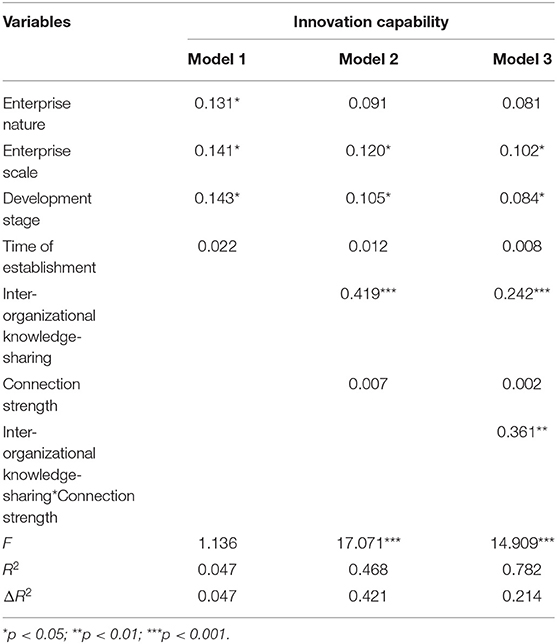
Table 9. Moderator effect test of connection strength between inter-organizational knowledge-sharing and innovation capability.
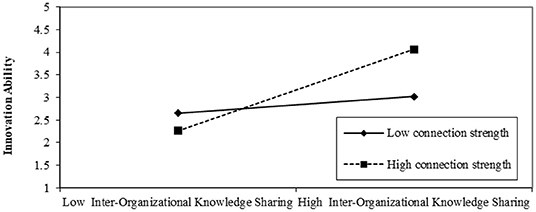
Figure 2. Moderator effect test t of connection strength between inter-organizational knowledge-sharing and innovation capability.
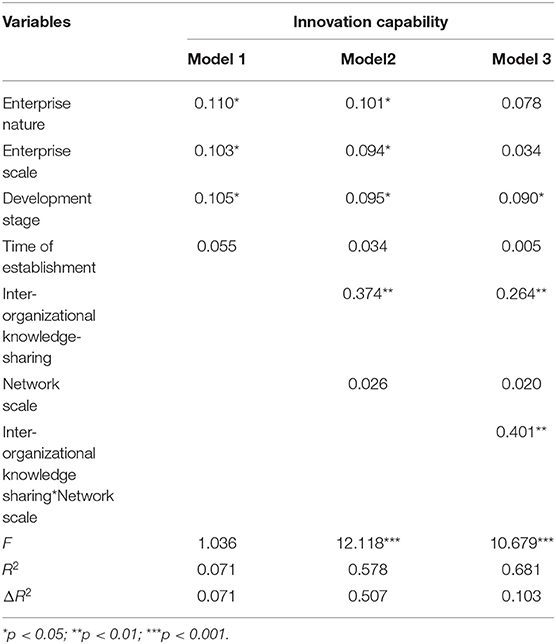
Table 10. Moderator effect test of network scale between inter-organizational knowledge-sharing and innovation capability.
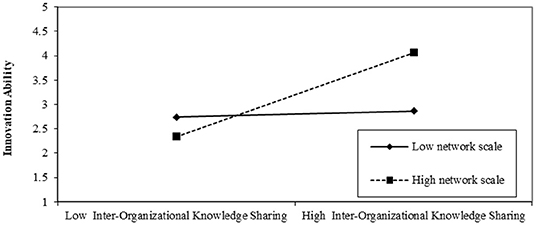
Figure 3. Moderator effect test of network scale between inter-organizational knowledge-sharing and innovation capability.
Theoretical model results show in Figure 4.
Discussion
This study takes high-tech manufacturing enterprises as research objects. Through a nonparametric test, this paper verifies the effect of inter-organizational knowledge-sharing on innovation capability and innovation performance, under the moderator effect of network characteristics.
First, inter-organizational knowledge-sharing has a positive effect on organizational innovation capability. This result is consistent with Hartley and Benington (2006) and Ahmad and Daghfous (2010). For Chinese high-tech enterprises, this factor plays an important role in influencing the innovation capability of high-tech enterprises. Through innovation networks and strategic alliances that provide information and key technical knowledge, Chinese high-tech enterprises learn, exchange and share knowledge with enterprises, universities and scientific research institutions, to improve organizational innovation capability.
Second, innovation capability has a positive impact on innovation performance. The empirical results verify this hypothesis, consistent with the previous research (e.g., Zhao et al., 2016). Innovation capability is a kind of dynamic ability for organizations to identify, acquire, learn and internalize valuable knowledge, to improve the quality of innovation (Enkel et al., 2010). Inter-organizational knowledge-sharing enriches the organization's knowledge base and improves the possibility of successful innovation. Innovation capability is the key reason an organization can use the knowledge innovation share among organizations to improve its innovation performance.
Third, innovation capability plays a mediator role in the interaction of knowledge-sharing and innovation performance. The empirical study results are different from common sense that some people believe (Gloet and Terziovski, 2004; Zeng et al., 2010). This study finds that inter-organizational knowledge-sharing does not directly promote innovation performance. However, innovation capability plays a mediator role in the interaction of knowledge-sharing and innovation performance. One of the reasons may be that scholars define innovation capability differently, scholars equating innovation capability with innovation performance (Lin et al., 2010; Zawislak et al., 2012). This swap between concepts brings flaws to the theory of innovation. According to the research results of Parashar and Singh (2005), this study from the perspective of ability defines innovation capability as knowledge absorption, transformation and network cooperation ability. It significantly distinguishes two concepts—innovation capability and innovation performance—while deeply exploring the relationship between inter-organizational knowledge-sharing and innovation capability. Another explanation for the empirical research result is that inter-organizational knowledge-sharing cannot be directly transformed into organizational innovation performance. It requires the process of organizational internalization, in which innovation capability plays the role of internalizing external knowledge. This explanation is consistent with the research results of Zahara and George (2002).
Fourth, the connection strength has a positive moderating effect on the relationship between inter-organizational knowledge-sharing and innovation capability. This result is contrary to that of Uzzi (1997) and Gargiulo and Benassi (2000). The possible reason is that the strategic partners of Chinese high-tech enterprises are more clearly from heterogeneous markets, such as enterprises participating in the supply chain, universities and scientific research institutions. Inter-organizational knowledge-sharing between heterogeneous markets requires establishing close relationships. This result is consistent with Gao et al. (2019).
Fifth, network scale has a significant moderating effect on the relationship between inter-organizational knowledge-sharing and innovation capability. The empirical results show that the larger scale of the inter-organizational knowledge-sharing network is, the more positive the effect of inter-organizational knowledge-sharing on innovation capability. The possible explanation is that the larger the scale of the inter-organizational knowledge-sharing network is, and the more organization members participate in knowledge-sharing, the more organizations can obtain diversified knowledge and improve organizational innovation capability, the finding is consistent with Möller and Rajala (2007).
Theoretical Implications
With the development of the new research model, the theoretical contributions of this paper to the literature are as follows.
First, this study enriches the research on innovation. Although this is a core concept in the literature, a significant gap remains in understanding the effect of inter-organizational knowledge-sharing on innovation performance (Wagner and Buko, 2005; Im and Rai, 2008). This study attempts to bridge the gap by identifying inter-organizational knowledge-sharing behaviors and studying their impact on organizational innovation performance. It links inter-organizational knowledge-sharing with innovation capability and suggests that inter-organizational knowledge-sharing must be transformed into innovation capability to improve organizational innovation performance, making a theoretical contribution to the discussion of organizational performance management in alliances or strategic cooperation networks.
Second, this study enriches the research on resource-based theory, to which we add the application and development of resource-based theory. The traditional resource-based theory contends that enterprises acquire and manage resources from a static perspective. It emphasizes the significance of the heterogeneous resources the enterprise owns for the construction of core competence and competitive advantage. This study explains the formation and evolution of enterprise core resources from a dynamic perspective, enriching the resource-based theory. This study proposes that the improvement of enterprise innovation performance requires enterprises to break through their network boundary and cooperate with external stakeholders, so they can enrich existing resources and build diversified resources. Enterprises benefit from integrating and utilizing external knowledge resources to improve their innovation ability and cope with the dynamic market environment.
Third, this study enriches the research on network embedded theory. This paper further discusses the relationship between inter-organizational knowledge-sharing and innovation performance under the moderation of knowledge network characteristics. In the dynamic environment, the higher the connection strength and the wider the network scale are needed to produce greater profits and positive cooperation quality (Gao et al., 2019). As previous scholars have suggested (De Wulf et al., 2001), the closer the relationship between knowledge-sharing partners is, the higher the degree of knowledge-sharing is. In addition, a large network scale promotes cooperation and supports the improvement of organizational innovation capability.
Managerial and Practical Implications
This study provides insights for managers and practices seeking to improve innovation performance.
First, managers increasingly welcome inter-organizational knowledge-sharing which helps the organization achieve enterprise innovation objectives (Im and Rai, 2008; Cheung et al., 2011). The most important management significance and practical enlightenment are that developing a positive and strong cooperative relationship is the key to strengthening knowledge-sharing among organizations. Therefore, in management practice, enterprises should make great efforts to build external network connections to advance knowledge-sharing between organizations, by establishing long-term cooperative guidance for further interaction. The establishment of strong network connections will increase tacit understanding between organizations, facilitate learning and imitation between them, make enterprise disciplines interdependent, and realize the transfer of high-quality information and knowledge. Therefore, enterprises should maintain more external connections, to obtain diversified knowledge and information, expand the intellectual reserve of innovation and improve enterprise innovation performance. Besides, enterprises must view inter-organizational knowledge-sharing from the perspective of strategic development. They should not only focus on internal knowledge exchange and sharing activities but also focus on external knowledge-sharing, internalization, diffusion and accumulation, to provide the necessary intellectual reserve for the improvement of enterprise innovation performance.
Second, innovation capability helps enterprises to effectively deal with an external volatile environment (including customers' dynamic demands). Furthermore, innovation capability helps enterprises to obtain and integrate external resources and improve enterprise innovation performance. Therefore, enterprise managers must put a high value on the shaping of organizational innovation capability. Organizations might invest in promoting inter-unit exchanges and in creating meaningful social nets for more innovative products and better performance.
Conclusion and Limitations
In this paper, we develop a new research model to understand the relationship between inter-organizational knowledge-sharing and innovation performance. We found that the effect of inter-organizational knowledge-sharing on innovation performance is realized through innovation capability. We also find that the characteristics of knowledge-sharing networks affect the relationship between inter-organizational knowledge-sharing and innovation capability. Organizations in close relationships are more conducive to the transfer of knowledge. The larger the network scale of knowledge-sharing is, the more multisource and heterogeneous knowledge organizations can obtain.
This study suffers from methodological limitations typical of most empirical surveys. The findings of the study cannot be generalized to all forms of organizations, as these findings reflect the setting of high-tech manufacturing enterprises in Shandong, China. From the perspective of the knowledge network, the research model only considers the moderator effect of connection strength and network scale on the relationship between inter-organizational knowledge-sharing and innovation capability. It does not consider the effect of industry background and cultural background. There is no further discussion about different types of knowledge-sharing in this model, such as the difference between implicit knowledge-sharing and explicit knowledge-sharing. In the future study, such issues could be brought into the model for the further exploration of the relationship between explicit and implicit knowledge-sharing, network characteristics, and innovation performance within different backgrounds. Besides, this study mainly uses cross-sectional data to verify hypotheses. Time-series data can serve as a hypothesis test in the future.
Data Availability Statement
The original contributions presented in the study are included in the article/supplementary material, further inquiries can be directed to the corresponding author.
Author Contributions
WD is responsible for writing the paper. ZY guides the paper. ZX is responsible for data collection and data analysis. JC is responsible for revising the language of the paper. LX and HC put forward many constructive suggestions for the paper. All authors contributed to the article and approved the submitted version.
Funding
The study was supported by Social Science Planning of Shandong Province (No. 21CSDJ44).
Conflict of Interest
The authors declare that the research was conducted in the absence of any commercial or financial relationships that could be construed as a potential conflict of interest.
The reviewer HY declared a shared affiliation with the authors to the handling editor at the time of review.
Publisher's Note
All claims expressed in this article are solely those of the authors and do not necessarily represent those of their affiliated organizations, or those of the publisher, the editors and the reviewers. Any product that may be evaluated in this article, or claim that may be made by its manufacturer, is not guaranteed or endorsed by the publisher.
Acknowledgments
The authors thank the editor and three reviewers for their comments and constructive suggestions.
References
Ahmad, N., and Daghfous, A. (2010). Knowledge sharing through inter-organizational knowledge networks: Challenges and opportunities in the United Arab Emirates. Eur. Bus. Rev. 22, 153–174. doi: 10.1108/09555341011023506
Ahuja, G. (2000). Collaboration networks, structural holes, and innovation: a longitudinal study. Adminis. Sci. Q. 45, 425–455. doi: 10.2307/2667105
Al-Busaidi, K. A., and Olfman, L. (2017). Knowledge sharing through inter-organizational knowledge sharing systems. J. Inform. Knowl. Manage. Syst. 47, 110–136. doi: 10.1108/VJIKMS-05-2016-0019
Aljuwaiber, A. (2016). Communities of practice as an initiative for knowledge sharing in business organizations: a literature review. J. Knowl. Manage. 20, 731–748. doi: 10.1108/JKM-12-2015-0494
Alkhuraiji, A., Liu, S., and Oderanti, F. O. (2016). New structured knowledge network for strategic decision-making in IT innovative and implementable projects. J. Bus. Res. 69, 1534–1538. doi: 10.1016/j.jbusres.2015.10.012
Andersson, U., Forsgren, M., and Holm, U. (2002). The strategic impact of external networks: Subsidiary performance and competence development in the multinational corporation. Strat. Manage. J. 23, 979–996. doi: 10.1002/smj.267
Andrade, R., Ramirez Solis, M. G., and JianJun, Z. J. (2018) Innovation and network multiplexity: RandD the concurrent effects of two collaboration networks in an emerging economy. Res. Policy. 47, 1111–1124. doi: 10.1016/j.respol.2018.03.018
Andrea, M. H. (2008). Contrasting the resource-based view and competitiveness theories: how pharmaceutical firms choose to compete in Germany, Italy and the UK. Strateg. Organ. 6, 343–374. doi: 10.1177/1476127008096362
Barney, J. B. (1996). The resource-based theory of the firm. Organ. Sci. 7, 469–469. doi: 10.1287/orsc.7.5.469
Baron, R. M., and Kenny, D. A. (1986). The moderator-mediator variable distinction in social psychological research: Conceptual, strategic, and statistical considerations. J. Pers. Soc. Psychol. 151, 11–73. doi: 10.1037/0022-3514.51.6.1173
Batjargal, B. (2007). Internet entrepreneurship: Social capital, human capital, and performance of Internet ventures in China. Res. Policy. 36, 605–618. doi: 10.1016/j.respol.2006.09.029
Bevan, D., Kowta, S, and Chitale, C. M. (2012). Collaborative knowledge sharing strategy to enhance organizational learning. J. Manage. Dev. 31, 308–322. doi: 10.1108/02621711211208934
Burt, R. S. (1992). Structural Holes: The Social Structure of Competition. Cambridge: Harvard University Press.
Burt, R. S. (2000). The network structure of social capital. Res. Organ. Behav. 22, 345–423. doi: 10.1016/S0191-3085(00)22009-1
Cai, W. G., and Zhou, X. L. (2014). On the drivers of eco-innovation: empirical evidence from China. J. Clean. Prod. 79, 239–248. doi: 10.1016/j.jclepro.2014.05.035
Capaldo, A. (2007). Network structure and innovation: The leveraging of a dual network as a distinctive relational capability. Strateg. Manage. J. 28, 585–608. doi: 10.1002/smj.621
Carlsson, S. A. (2003). Knowledge managing and knowledge management systems in inter-organizational networks. Knowl. Process Manage. 10, 194–206.9 doi: 10.1002/kpm.179
Cerchione, R., Esposito, E., and Spadaro, M. R (2015). The spread of knowledge management in SMEs: a scenario in evolution. Sustainability. 7, 10210–10232. doi: 10.3390/su70810210
Chang, PL, and Shih, HY. (2005). Comparing patterns of intersectoral innovation diffusion in Taiwan and China: a network analysis. Technovation. 25, 155–169. doi: 10.1016/S0166-4972(03)00077-4
Chen, J., Yin, X., and Mei, L. (2018). Holistic innovation: an emerging innovation paradigm. Int. J. Innov. Stud. 2, 1–13. doi: 10.1016/j.ijis.2018.02.001
Cheung, M. S., Myers, M. B., and Mentzer, J. T. (2011). Does relationship learning lead to relationship value? A cross-national supply chain investigation. J. Oper. Manage. 28, 472–487. doi: 10.1016/j.jom.2010.01.003
Dasai, L., Ruixia, W., and Bing, L. (2016). Research on the Influence of Intellectual Capital on Enterprise Innovation capability based on Life Cycle. J. Indus. Technol. Econ. 0-11.
Dayasindhu, N. (2002). Embeddedness, knowledge transfer, industry clusters and global competitiveness: a case study of the Indian software industry. Technovation. 22, 551–560. (01)00098-0. doi: 10.1016/S0166-4972(01)00098-0
De Wulf, K., Odekerken-Schröder, G., and Iacobucci, D. (2001). Investments in consumer relationships: A cross-country and cross-industry exploration. J. Market. 65, 33–50. doi: 10.1509/jmkg.65.4.33.18386
De Wulf, K., Odekerken-Schröder, G., and Van Kenhove, P. (2003). Investments in consumer relationships: a critical reassessment and model extension. Int. Rev. Retail Distrib. Consum. Res.13, 245–261. doi: 10.1080/0959396032000101354
De Zubielqui, G. C., Jones, J., Seet, P. S., and Lindsay, N. (2015). Knowledge transfer between actors in the innovation system: a study of higher education institutions (HEIS) and SMEs. J. Bus. Indus. Mark. 30, 436–458. doi: 10.1108/JBIM-07-2013-0152
Dekker, H. C., and Van den Abbeele, A. (2010). Organizational learning and inter-firm control: The effects of partner search and prior exchange experiences. Organ. Sci., 21, 1233–1250. doi: 10.1287/orsc.1090.0505 Available online at: https://sk.sagepub.com/books/download/the-contingency-theory-of-organizations/n2.pdf (accessed April 1, 2014).
Enkel, E., Gassmann, O., and Chesbrough, H. (2010). Open R&D and open innovation: exploring the phenomenon. R&D Manag. 39, 311–316. doi: 10.1111/j.1467-9310.2009.00570.x
Estrada, I., Faems, D., and Faria, P.D. (2016). Co-opetition and product innovation performance: the role of internal knowledge sharing mechanisms and formal knowledge protection mechanisms. Indus. Market. Manage. 53, 56–65. doi: 10.1016/j.indmarman.2015.11.013
Faems, D., Visser, M. D., and Andries, P. (2010). Technology alliance portfolios and financial performance: value-enhancing and cost-increasing effects of open innovation. J. Product. Innov. Manage. 27, 785–796. doi: 10.1111/j.1540-5885.2010.00752.x
Ferriani, S., Fonti, F., and Corrado, R. (2013). The social and economic bases of network multiplexity: exploring the emergence of multiplex ties. Strateg. Organ. 11, 7–34. doi: 10.1177/1476127012461576
Fornell, C., and Larcker, D. F. (1981). Structural equation models with unobservable variables and measurement error: algebra and statistics. J. Market. Res. (JMR). 18, 39–50. doi: 10.1177/002224378101800104
Franco, M., and Haase, H. (2015). Interfirm alliances: a taxonomy for SMEs. Long Range Plann. 48, 168–81. doi: 10.1016/j.lrp.2013.08.007
Furrer, O., Sudharshan, D., Thomas, H., and Alexandre, M. T. (2008). Resource configurations, generic strategies, and firm performance. J Strateg. Manage.1, 15–40. doi: 10.1108/17554250810909400
Gao, S., Yin, F., Chen, J., and Guo, Y. (2019). The mechanism of inter-organizational collaboration network on innovation performance: evidence from east coastal enterprises in China. J. Coast. Res. 94, 945–949. doi: 10.2112/SI94-186.1
Gargiulo, M., and Benassi, M. (2000). Trapped in your own net? Network cohesion, structural holes, and the adaptation of social capital. Organ. Sci. 11, 183–196. doi: 10.1287/orsc.11.2.183.12514
Gassmann, O., Enkel, E., and Chesbrough, H. (2010). The future of open innovation. R&D Manage. 40, 213–221. doi: 10.1111/j.1467-9310.2010.00605.x
Gatignon, H. (2010). Confirmatory Factor Analysis Statistical Analysis of Management Data. Berlin: Springer. p. 59–112.
Gemünden, H. G., Ritter, T., and Heydebreck, P. (1996). Network configuration and innovation success: An empirical analysis in German high-tech industries. Int J Res Market. 13, 449–462. (96)00026-2. doi: 10.1016/S0167-8116(96)00026-2
Gloet, M., and Terziovski, M. (2004). Exploring the relationship between knowledge management practices and innovation performance. J. Manuf. Technol. Manag. 15, 402–409. doi: 10.1108/17410380410540390
Gnyawali, D. R., and Park, B. J. R. (2010). Co-opetition and technological innovation in small and medium-sized enterprises: a multilevel conceptual model. J. Small. Bus. Manage. 47, 308–330. doi: 10.1111/j.1540-627X.2009.00273.x
Gomezel, A. S., and Rangus, K. (2018). An exploration of an entrepreneur's open innovation mindset in an emerging country. Manage. Dec. 56, 1869–1882. doi: 10.1108/MD-04-2017-0382
Granovetter, M. (1978). Threshold models of collective behavior. Am. J. Sociol. 83, 1420–1443. doi: 10.1086/226707
Granovetter, M. (1985). Economic action and social structure: the problem of embeddedness. Am. J. Sociol. 91, 481–510. doi: 10.1086/228311
Grant, R.M. (1996b). Prospering in dynamically-competitive environments: organizational capability as knowledge integration. Organ. Sci. 7, 375–387. doi: 10.1287/orsc.7.4.375
Grant, R. M. (1991). The resource-based theory of competitive advantage: implications for strategy formulation. Calif. Manag. Rev. 33, 114–135. doi: 10.2307/41166664
Grant, R. M. (1996a). Toward a knowledge-based theory of the firm. Strategic. Manage. J. 17, 109–122. doi: 10.1002/smj.4250171110
Grewal, R., Lilien, G. L., and Mallapragada, G. (2006). Location, location, location: How network embeddedness affects project success in open source systems. Manag. Sci. 52, 1043–1056. doi: 10.1287/mnsc.1060.0550
Gulati, R. (1998). Alliances and networks. Strategic. Manage. J. 19, 293–317. doi: 10.1002/(SICI)1097-0266(199804)19:4<293::AID-SMJ982>3.0.CO;2-M
Gupta, S., and Polonsky, M. (2014). Inter-firm learning and knowledge-sharing in multinational networks: An outsourced organization's perspective. J. Bus. Res. 67, 615–622. doi: 10.1016/j.jbusres.2013.02.043
Hagedoorn, J. (2006). Understanding the cross-level embeddedness of interfirm partnership formation. Mathema. Soc. Sci. 31, 670–680. doi: 10.5465/amr.2006.21318924
Hamel, G. (1991). Competition for competence and inter-partner learning within international strateg-ic alliances. Strateg. Manage. J. 13, 83–103. doi: 10.1002/smj.4250120908
Hamel, G., and Prahalad, C. K. (1990). The core competency of a corporation. Harvard. Bus. Rev. 68, 79–91.
Hartley, J., and Benington, J. (2006). Copy and paste, or graft and transplant? Knowledge sharing through inter-organizational networks. Public. Money. Manage. 26. doi: 10.1111/j.1467-9302.2006.00508.x
Healey, M. P., Querbes, A., and Bleda, M. (2021). Costs of collective wisdom: how resources influence information aggregation in organizational decision making. Strateg. Organ. 3, 1–28. doi: 10.1177/14761270211003849
Hurley, R. F., Hult, G. T. M., and Knight, G. A. (2015). Innovativeness and capacity to innovate in the complexity of firm-level relationships: a response to Woodside (2004). Indus. Market. Manage. 34, 281–283. doi: 10.1016/j.indmarman.2004.07.006
Im, G., and Rai, A. (2008) Knowledge sharing ambidexterity in long-term inter-organizational relationships. Manage. Sci. 54, 1281–1296. doi: 10.1287/mnsc.1080.0902
Isaac, V. R., Borini, F. M., Raziq, M. M., and Benito, G. R. (2019). From local to global innovation: the role of subsidiaries' external relational embeddedness in an emerging market. Int. Bus. Rev. 28, 638–646. doi: 10.1016/j.ibusrev.2018.12.009
Jarillo, J. C. (1988). On strategic networks. Strateg. Manage. J. 9, 31–41. doi: 10.1002/smj.4250090104
Kaminska, R., and Borzillo, S. (2016). Organizing for sustained innovation: the role of knowledge flows within and between organizational communities. Knowl. Manage. Res. Pract. 14, 46–54. doi: 10.1057/kmrp.2014.31
Khanna, T., Gulati, R., and Nohria, N. (1998). The dynamics of learning alliances: competition, cooperation, and relative scope. Strategi. Manage. J. 19, 193–210. doi: 10.1002/(SICI)1097-0266(199803)19:3<193::AID-SMJ949>3.0.CO;2-C
Kim, N., and Shim, C. (2018). Social capital, knowledge sharing and innovation of small-and-medium-sized enterprises in a tourism cluster. Int. J. Contemp. Hospital. Manage. 30, 2417–2437. doi: 10.1108/IJCHM-07-2016-0392
Kline, R. B. (2015). Principles Practice of Structural Equation Modeling. New York: Guilford publications.
Kowlaser, K., and Barnard, H. (2016). Tie breadth, tie strength and the location of ties: the value of ties inside an emerging MNC to team innovation. Int. J. Innov. Manage. 20, 165–206. doi: 10.1142/S1363919616500067
Kraatz, M. S. (1998). Learning by Association? Inter-organizational Networks and Adaptation to Environmental Change. Acad. Manage. J. 41, 621–643. doi: 10.2307/256961
Kumaraswamy, K. S. N., and Chitale, C.M. (2012). Collaborative knowledge sharing strategy to enhance organizational learning. J. Manage. Dev. 31, 308–322.
Lavie, D., and Miller, S. R. (2008). Alliance portfolio internationalization and firm performance. Organ. Sci., 19, 623–646. doi: 10.1287/orsc.1070.0341
Lawson, B., and Samson, D. (2001). Developing Innovation Capability in Organizations: a Dynamic Capabilities Approach. Int. J. Innov. Manag. 5, 377–400. doi: 10.1142/S1363919601000427
Lee, J. N. (2001). The impact of knowledge sharing, organizational capability and partnership quality on IS outsourcing success. Inform. Manag. 38, 323–335. doi: 10.1016/S0378-7206(00)00074-4
Lee, K., and Yoo, J. (2019). How does open innovation lead to competitive advantage? A dynamic capability view perspective. PloS One. 14, 22–34. doi: 10.1371/journal.pone.0223405
Li, X., and Peng, T. (2008). Innovation environment of high-tech zones and enterprise innovation capability. Reform. Strateg. 41, 17–33. doi: 10.3390/joitmc7010066
Liao, Y., and Marsillac, E. (2015). External knowledge acquisition and innovation: The role of supply chain network-oriented flexibility and organizational awareness. Int. J. Prod. Res. 53, 5437–5455. doi: 10.1080/00207543.2015.1008106
Lin, R., Chen, R., and Kuan Shun Chiu, K. (2010). Customer relationship management and innovation capability: an empirical study. Indus. Manag. Data Syst. 110, 111–133. doi: 10.1108/02635571011008434
Liu, J., Dietz, T., Carpenter, S. R., Alberti, M., Folke, C., Moran, E., et al. (2007). Complexity of coupled human and natural systems. Science 317, 1513–1516. doi: 10.1126/science.1144004
Lotti Oliva, F. (2014). Knowledge management barriers, practices and maturity model. J. Knowl. Manag., 18, 1053–1074. doi: 10.1108/JKM-03-2014-0080
Lovallo, D., Brown, A. L., Teece, D. J., and Bardolet, D. (2020). Resource re-allocation capabilities in internal capital markets: The value of overcoming inertia. Strategic. Manage. J. 41, 1365–1380. doi: 10.1002/smj.3157
Maritan, C. A., and Peteraf, M. A. (2011). Building a bridge between resource acquisition and resource accumulation. J. Manag., 37, 1374–1389. doi: 10.1177/0149206310387675
Marra, M., Ho, W., and Lee, C. (2017). Managing supply chain knowledge-based linkages for improving operational performance. Knowl. Manag. Rese. Pract. 14, 256–269 doi: 10.1057/kmrp.2014.28
McEvily, B., and Marcus, A. (2005). Embedded ties and the acquisition of competitive capabilities. Strateg. Manage. J. 26, 1033–1055. doi: 10.1002/smj.484
Mokhtarzadeh, N. G., Mahdiraji, H. A., Jafarpanah, I., Jafari-Sadeghi, V., and Cardinali, S. (2020). Investigating the impact of networking capability on firm innovation performance: using the resource-action-performance framework. J. Intell. Capital, 21, 1009–1034. doi: 10.1108/JIC-01-2020-0005
Möller, K., and Rajala, A. (2007). Rise of strategic nets-New modes of value creation. Indus. Market. Manag., 36, 895–908. doi: 10.1016/j.indmarman.2007.05.016
Omar, A., Davis Sramek, B., Myers, M. B., and Mentzer, J. T. (2012). A global analysis of orientation, coordination, and flexibility in supply chains. J. Bus. Logist. 33, 128–144. doi: 10.1111/j.0000-0000.2012.01045.x
Parashar, M., and Singh, S. K. (2005). Innovation capability. IIMB. Manage. Rev. 17, 115–123. Available online at: https://www.researchgate.net/publication/293125359_Innovation_capability
Park, H., Seongryong, N. A., and Jeon, J. (2007). Compromise allocation in univariate stratified sampling. Commun. Ststist. A, Theor. Methods. 36, 265–271. doi: 10.1080/03610920600974609
Partanen, J., Chetty, S. K., and Rajala, A. (2014). Innovation types and network relationships. Entrepreneurship. Theory. Pract. 38, 168–179. doi: 10.1111/j.1540-6520.2011.00474.x
Paswan, A. K., D'Souza, D., and Rajamma, R. K. (2014). Value co-creation through knowledge exchange in franchising. J. Serv. Market. 28, 116–125. doi: 10.1108/JSM-09-2013-0254
Pavlovich, K., and Corner, P.D. (2006). Knowledge creation through co-entrepreneurship. Int. J. Knowl. Manag. Stud. 1, 178–197. doi: 10.1504/IJKMS.2006.008852
Porter Panteli, N., and Sockalingam, S. (2005). Trust and conflict within virtual inter-organizational alliances: a framework for facilitating knowledge sharing. Dec. Support Syst, 39, 599–617. doi: 10.1016/j.dss.2004.03.003
Porter, M. E., and Stern, S. (2001). Innovation: location matters. MIT Sloan Manage. Rev. 42, 28–36. Available online at: https://dialnet.unirioja.es/servlet/articulo?codigo=2376304
Powell, W. W., Koput, K. W., and Smith-Doerr, L. (1996). Inter-organizational collaboration and the locus of innovation: networks of learning in biotechnology. Admin. Sci. Q. 41, 116–145. doi: 10.2307/2393988
Prabhakar, G. V., and Savinkina, L. A. (2018). Knowledge conversion processes and organizational performance. Int. J. Knowl. Manage. Stud. 9, 342–366. doi: 10.1504/IJKMS.2018.096315
Prahalad, C. K., and Hamel, G. (1990). The core competence of the corporation. Harvard Bus. Rev. 68, 79–91.
Qi Dong, J., McCarthy, K. J., and Schoenmakers, W. W. (2017). How central is too central? Organizing inter-organizational collaboration networks for breakthrough innovation. J. Prod. Innov. Manage. 34:526–542 doi: 10.1111/jpim.12384
Quintane, E., Mitch Casselman, R., Sebastian Reiche, B., and Nylund, P. A. (2011). Innovation as a knowledge-based outcome. J. Knowl. Manag., 15, 928–947. doi: 10.1108/13673271111179299
Rindfleisch, A., and Moorman, C. (2001). The acquisition and utilization of information in new product alliances: a strength-of-ties perspective. J. Market. 65, 1–18. doi: 10.1509/jmkg.65.2.1.18253
Ritter, T., and Gemunden, H. G. (2003). Network competence: Its impact on innovation success and its antecedents. J. Bus. Res. 56, 745–755. doi: 10.1016/S0148-2963(01)00259-4
Rowley, T., Behrens, D., and Krackhardt, D. (2000). Redundant governance structures: an analysis of structural and relational embeddedness in the steel and semiconductor industries. Strateg. Manag. J. 21, 369–386. doi: 10.1002/(SICI)1097-0266(200003)21:3<369::AID-SMJ93>3.0.CO;2-M
Sanchez, J. A. L., Vijande, M. L. S., and Gutierrez, J. A. T. (2010). Organizational learning and value creation in business networks. Eur. J. Market. 44, 1612–1641. doi: 10.1108/03090561011079819
Saxton, T. (1997). The effects of partner and relationship characteristics on alliance outcomes. Acad. Manag. J. 40, 443–461. doi: 10.5465/256890
Schilling, M. A., and Phelps, C. C. (2007). Interfirm collaboration networks: The impact of large-scale network structure on firm innovation. Manage. Sci., 53, 1113–1126. doi: 10.1287/mnsc.1060.0624
Semrau, T., and Werner, A. (2014). How exactly do network relationships pay off? The effects of network size and relationship quality on access to start-up resources. Entrepreneur. Theor. Pract. 38, 501–525. doi: 10.1111/etap.12011
Shazi, R., Gillespie, N., and Steen, J. (2015). Trust as a predictor of Innov network ties in project teams. Int. J. Project Manag. doi: 10.1016/j.ijproman.2014.06.001
Sheng, M. L., Hartmann, N. N., Chen, Q., and Chen, I. (2015). The synergetic effect of multinational corporation management's social cognitive capability on tacit-knowledge management: Product innovation ability insights from Asia. J. Int. Market. 23, 94–110. doi: 10.1509/jim.14.0094
Sirmon, D., Hitt, G. M., and Ireland, A. (2007). Managing firm resources in dynamic environments to create value: looking inside the black box. Acad. Manag. Rev. 32, 273–292. doi: 10.5465/amr.2007.23466005
Stuart, T. E. (2015). Inter-organizational alliances and the performance of firms: a study of growth and innovation rates in a high-technology industry. Strateg. Manag. J. 21, 791–811. doi: 10.1002/1097-0266(200008)21:8<791::AID-SMJ121>3.0.CO;2-K
Stuart, T. E., and Sorenson, O. (2007). Strategic networks and entrepreneurial ventures. Strateg. Entrepreneur. J. 1, 211–227. doi: 10.1002/sej.18
Swierczek, A. (2019). Manufacturer structural embeddedness the network rent: The intervening role of relational embeddedness in the triadic supply chains. Supply Chain Manag. Int. J. 24, 334–354. doi: 10.1108/SCM-06-2018-0232
Tamer Cavusgil, S., Calantone, R. J., and Zhao, Y. (2003). Tacit knowledge transfer and firm innovation capability. J. Bus. Indus. Market. 18, 6–21. doi: 10.1108/08858620310458615
Tang, F., Mu, J., and Maclcahlan, D. L. (2008). Implication of network size and structure on organizations' knowledge transfer. Expert. Syst. Appl. 34, 1109–1114. doi: 10.1016/j.eswa.2006.12.020
Teece, D., and Pisano, G. (1994). The dynamic capabilities of firms: An introduction. Indust. Corp. Chang. 3, 537–556. doi: 10.1093/icc/3.3.537-a
Teece, D. J., Pisano, G., and Shuen, A. (1997). Dynamic capabilities and strategic management. Strateg. Manag. J. 18, 509-533. doi: 10.1002/(SICI)1097-0266(19970)18:7<509::AID-SMJ882>3.0.CO;2-Z
Teece, D. J., Pisano, G., and Shuen, A. (2015). Capabilities and strategic management. Strateg. Manag. J. 18, 509–533. doi: 10.1002/(SICI)1097-0266(199708)18:7<
Tomlinson, P. R. (2011). Strong ties, substantive embeddedness and innovation: exploring differences in the innovative performance of small and medium-sized firms in UK manufacturing. Knowl. Process Manage. 18, 95–108. doi: 10.1002/kpm.376
Usoro, A., Sharratt, M. W., Tsui, E., and Shekhar, S. (2007). Trust as an antecedent to knowledge sharing in virtual communities of practice. Knowl. Manage. Res. Pract. 5, 199–212. doi: 10.1057/palgrave.kmrp.8500143
Uzzi, and Brian. (1997). Towards a network perspective on organizational decline. International J. Sociol. Soc. Pol. 17, 111–155. doi: 10.1108/eb013318
Van Hemert, P. P. (2012). The Influence of Innovation Sources Networks on the Performance of Dutch SMEs (Doctoral dissertation, Doctoral thesis).
Van Wijk, R., Jansen, J. J. P., and Lyles, M. A. (2008). Inter- and intra-organizational knowledge transfer: a meta-analytic review and assessment of its antecedents and consequences. J. Manag. Stud. 45, 830–853. doi: 10.1111/j.1467-6486.2008.00771.x
Vătămănescu, E-. M., Cegarra-Navarro, J-. G., Andrei, A. G., Dincă, V. M., and Alexandru, V. A. (2020). SMEs strategic networks and innovative performance: a relational design and methodology for knowledge sharing. J. Knowl. Manag., 24, 1369–1392. doi: 10.1108/JKM-01-2020-0010
Veenswijk, M., Marrewijk, A. V., and Boersma, K. (2010). Developing new knowledge in collaborative relationships in megaproject alliances: organizing reflection in the dutch construction sector. Int. J. Knowl. Manage. Stud., 4, 216–232. doi: 10.1504/IJKMS.2010.030793
Venkitachalam, K., and Bosua, R. (2014), Roles enabling the mobilization of organizational knowledge. J. Knowl. Manage. 18, 396–410. doi: 10.1108/JKM-08-2013-0304
Venkitachalam, K., and Willmott, H. (2015) Factors shaping organizational dynamics in strategic knowledge management. Knowl. Manage. Res. Pract. 13, 344–359. doi: 10.1057/kmrp.2013.54
Venkitachalam, K., and Willmott, H. (2017). Strategic knowledge management—insights and pitfalls. Int. J. Inf. Manage. 37, 313–316. doi: 10.1016/j.ijinfomgt.2017.02.002
Venkitachalam, K., and Ambrosini, V. (2017). A triadic link between knowledge management, information technology and business strategies. Knowl. Manage. Res. Pract. 15, 192–200. doi: 10.1057/s41275-016-0043-5
Vuori, V., Helander, N., and Maënpaä, S. (2019). Network level knowledge sharing: leveraging Riege's model of knowledge barriers. Knowl. Manag. Res. Pract. 17, 253–263. doi: 10.1080/14778238.2018.1557999
Wagner, S. M., and Buko, C. (2005). An empirical investigation of knowledge sharing in networks. J. Supply. Chain. Manag. 41, 17–31. doi: 10.1111/j.1745-493X.2005.04104003.x
Wang, C. H., Chin, T., and Lin, J. H. (2020). Openness and firm innovation performance: the moderating effect of ambidextrous knowledge search strategy. J. Knowl. Manag., 24, 301–323. doi: 10.1108/JKM-04-2019-0198
Wang, L., Li, E., and Ding, X. (2018). Does deliberate learning lead to dynamic capability? the role of organizational schema for Kodak, 1993-2011. J. strategy. Manag. 11, 62–80. doi: 10.1108/JSMA-11-2016-0083
Woschke, T., Haase, H., and Kratzer, J. (2017). Resource scarcity in SMEs: effects on incremental and radical innovations. Manage. Res. Rev. 40, 195–217. doi: 10.1108/MRR-10-2015-0239
Xie, X., Fang, L., and Zeng, S. (2016). Collaborative innovation network and knowledge transfer performance: a fsQCA approach. J. Bus. Res. 69, 5210–5215. doi: 10.1016/j.jbusres.2016.04.114
Yam, RC, Lo, W, Tang, EP, and Lau, AK. (2011). Analysis of sources of innovation, technological innovation capabilities, and performance: An empirical study of Hong Kong manufacturing industries. Res. Policy. 40, 391–402. doi: 10.1016/j.respol.2010.10.013
Yan, Y., and Guan, J. (2018). Social capital, exploitative and exploratory innovations: The mediating roles of ego-network dynamics. Technol. Forecast. Social. Change, 126, 244–258. doi: 10.1016/j.techfore.2017.09.004
Yang, J., Liu, H., Gao, S., and Li, Y. (2012). Technological innovation of firms in China: Past, present, and future. Asia. Pacific. J. Manag., 29, 819–840. doi: 10.1007/s10490-010-9243-3
Yao, J., Crupi, A., Di Minin, A., and Zhang, X. (2020). Knowledge sharing and technological innovation capabilities of Chinese software SMEs. J. Knowl. Manag. 24, 607–634. doi: 10.1108/JKM-08-2019-0445
Yildirim, N. (2017). Organizational learning through knowledge management systems: a case study on improvement of customer support processes. Int. J. Knowl. Manage. Stud. 8, 375–402. doi: 10.1504/IJKMS.2017.10007252
Zabala Iturriagagoitia, J. M., Jiménez-Sáez, F., Castro Martínez, E., and Gutiérrez Gracia, A. (2007). What indicators do (or do not) tell us about Regional Innovation Systems. Scientometrics, 70, 85–106. doi: 10.1007/s11192-007-0106-8
Zahara, S., and George, G. (2002). Absorptive capacity: a review, reconceptualization and extension. Acad. Manag. Rev. 27, 185–203. doi: 10.5465/amr.2002.6587995
Zawislak, P. A., Cherubini Alves, A., Tello Gamarra, J., Barbieux, D., and Reichert, F. M. (2012). Innovation capability: From technology development to transaction capability. J. Technol. Manage. Innov.7, 14–27. doi: 10.4067/S0718-27242012000200002
Zeng, S. X., Xie, X. M., and Tam, C. M. (2010). Relationship between cooperation networks and innovation performance of SMEs. Technovation. 30, 181–194. doi: 10.1016/j.technovation.2009.08.003
Zhao, L., and Aram, J. D. (1995). Networking and growth of young technology-intensive ventures in China. J. Bus. Ventur. 10, 349–370. doi: 10.1016/0883-9026(95)00039-B
Zhao, S., Sun, Y., and Xu, X. (2016). Research on open innovation performance: a review. Inf. Technol. Manag., 17, 279–287. doi: 10.1007/s10799-015-0231-7
Zhonglin, W., Kittai, H., and Lei, C. (2005). A comparison of moderator and mediator and their applications. Acta. Psychologica. Sinica, 37, 268–274. Available online at: https://journal.psych.ac.cn/acps/EN/Y2005/V37/I02/268
Keywords: inter-organizational knowledge-sharing, innovation ability, innovation performance, network scale, connection strength
Citation: Dongling W, Yuming Z, Xinmin L, Chen J, XiaoYi Z and Chang H (2022) Can Inter-organizational Knowledge-Sharing Improve Enterprise Innovation Performance? The Mediator Effect of Innovation Capability and the Moderator Effect of Network Characteristics. Front. Commun. 7:856301. doi: 10.3389/fcomm.2022.856301
Received: 17 January 2022; Accepted: 17 May 2022;
Published: 16 June 2022.
Edited by:
Krishna Venkitachalam, Estonian Business School, EstoniaReviewed by:
Patrick Wamuyu, United States International University - Africa, KenyaHailan Yang, Shandong Jianzhu University, China
Junwei Zheng, Kunming University of Science and Technology, China
Copyright © 2022 Dongling, Yuming, Xinmin, Chen, XiaoYi and Chang. This is an open-access article distributed under the terms of the Creative Commons Attribution License (CC BY). The use, distribution or reproduction in other forums is permitted, provided the original author(s) and the copyright owner(s) are credited and that the original publication in this journal is cited, in accordance with accepted academic practice. No use, distribution or reproduction is permitted which does not comply with these terms.
*Correspondence: Zhang Yuming, emhhbmd5dW1pbmdAc2R1LmVkdS5jbg==
 Wang Dongling
Wang Dongling Zhang Yuming1*
Zhang Yuming1* Zhang XiaoYi
Zhang XiaoYi